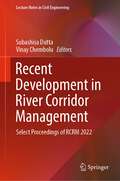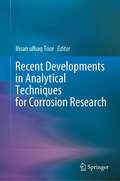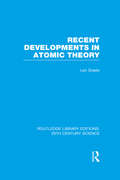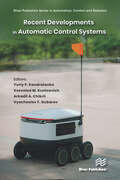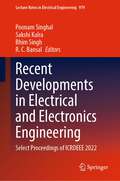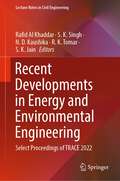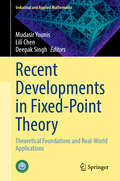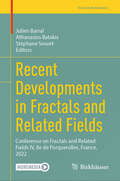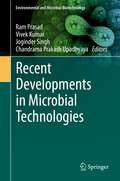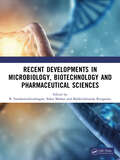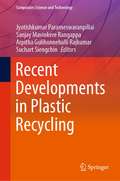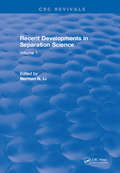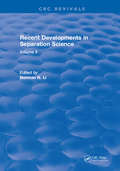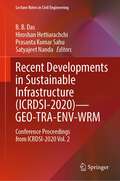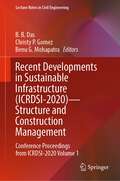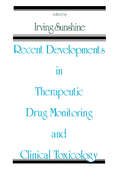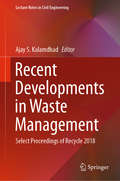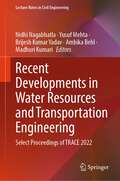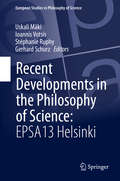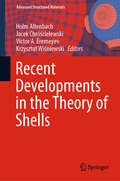- Table View
- List View
Recent Development in Clusters of Rare Earths and Actinides: Chemistry and Materials
by Zhiping ZhengChemical structure and bonding. The scope of the series spans the entire Periodic Table and addresses structure and bonding issues associated with all of the elements. It also focuses attention on new and developing areas of modern structural and theoretical chemistry such as nanostructures, molecular electronics, designed molecular solids, surfaces, metal clusters and supramolecular structures. Physical and spectroscopic techniques used to determine, examine and model structures fall within the purview of Structure and Bonding to the extent that the focus is on the scientific results obtained and not on specialist information concerning the techniques themselves. Issues associated with the development of bonding models and generalizations that illuminate the reactivity pathways and rates of chemical processes are also relevant. The individual volumes in the series are thematic. The goal of each volume is to give the reader, whether at a university or in industry, a comprehensive overview of an area where new insights are emerging that are of interest to a larger scientific audience.
Recent Development in River Corridor Management: Select Proceedings of RCRM 2022 (Lecture Notes in Civil Engineering #376)
by Subashisa Dutta Vinay ChemboluThis book presents the select proceedings of the 2nd International Conference on River Corridor Research and Management (2022). It describes various topics on fluvio-hydro-ecological processes of river systems. The topics covered include river hydraulics, river dynamics, experimental and field hydraulics and remote sensing applications. The book also discusses the river aquatic health, river ecology and other aligned areas. The book is a valuable reference for research scholars, academicians, river scientists and practitioners working in the areas of river science.
Recent Developments in Acoustics: Select Proceedings of the 46th National Symposium on Acoustics (Lecture Notes in Mechanical Engineering)
by Mahavir Singh Yasser RafatThis book presents the proceedings of the 46th National Symposium on Acoustics (NSA 2017). The main goal of this symposium is to discuss key opportunities and challenges in acoustics, especially as applied to engineering problems. The book covers topics ranging from hydro-acoustics, environmental acoustics, bio-acoustics to musical acoustics, electro-acoustics and sound perception. The contents of this volume will prove useful to researchers and practicing engineers working on acoustics problems.
Recent Developments in Analytical Techniques for Corrosion Research
by Ihsan Ulhaq ToorThis book covers a wide range of advanced analytical tools, from electrochemical to in-situ/ex-situ material characterization techniques, as well as the modeling of corrosion systems to foster understanding and prediction. When used properly, these tools can enrich our understanding of material performance (metallic materials, coatings, inhibitors) in various environments/contexts (aqueous corrosion, high-temperature corrosion). The book encourages researchers to develop new corrosion-resistant materials and supports them in devising suitable asset integrity strategies. Offering a valuable resource for researchers, industry professionals, and graduate students alike, the book shows them how to apply these valuable analytical tools in their work.
Recent Developments in Atomic Theory (Routledge Library Editions: 20th Century Science)
by Leo GraetzInto the short compass of this book Professor Graetz has succeeded in compressing an eminently readable survey of the directions in which the atomic theory, as accepted in the nineteenth century, has been extended by the remarkable and almost revolutionary physical investigations and discoveries of the two decades preceding the book’s original publication in 1923.
Recent Developments in Automatic Control Systems (River Publishers Series in Automation, Control and Robotics)
by Yuriy P. Kondratenko Arkadii A. Chikrii Vyacheslav F. Gubarev Vsevolod M. KuntsevichThis monograph provides an overview of the recent developments in modern control systems including new theoretical findings and successful examples of practical implementation of the control theory in different areas of industrial and special applications.Recent Developments in Automatic Control Systems consists of extended versions of selected papers presented at the XXVI International Conference on Automatic Control "Automation 2020" (October 13–15, 2020, Kyiv, Ukraine) which is the main Ukrainian Control Conference organized by the Ukrainian Association on Automatic Control (national member organization of IFAC) and the National Technical University of Ukraine "Igor Sikorsky Kyiv Polytechnic Institute".This is the third monograph in the River Publishers series in Automation, Control and Robotics based on the selected papers of the Ukrainian Control Conferences "Automation", in particular, the first monograph Control Systems: Theory and Applications (2018) was published based on "Automation – 2017" and the second monograph Advanced Control Systems: Theory and Applications was based on "Automation – 2018".The monograph is divided into three main parts: (a) Advances in Theoretical Research of Control Systems; (b) Advances in Control Systems Application; (c) Recent Developments in Collaborative Automation.The chapters have been structured to provide an easy-to-follow introduction to the topics that are addressed, including the most relevant references, so that anyone interested in this field can get started in the area.This book may be useful for researchers and students who are interesting in recent developments in modern control systems, robust adaptive systems, optimal control, fuzzy control, motion control, identification, modelling, differential games, evolutionary optimization, reliability control, security control, intelligent robotics and cyber–physical systems.
Recent Developments in Electrical and Electronics Engineering: Select Proceedings of ICRDEEE 2022 (Lecture Notes in Electrical Engineering #979)
by Bhim Singh Poonam Singhal Sakshi Kalra R. C. BansalThis book contains cutting-edge research content presented by researchers, engineers, developers, and practitioners from academia and industry at the International Conference on Recent Developments in Electrical and Electronics Engineering (ICRDEEE 2022). The materials in the book include theory and applications for different areas of Electrical and Electronics Engineering. The topics covered include power systems and protection, energy, electric vehicles, smart grid, semiconductor technologies, electrical machines and drives, control systems with artificial intelligence, etc. The content is useful for researchers, professionals, and academicians in understanding current research trends, findings, and future scope of research in electrical and electronics engineering models.
Recent Developments in Energy and Environmental Engineering: Select Proceedings of TRACE 2022 (Lecture Notes in Civil Engineering #333)
by S. K. Jain N. D. Kaushika S. K. Singh R. K. Tomar Rafid Al KhaddarThis book comprises select proceedings of the International Conference on Trends and Recent Advances in Civil Engineering (TRACE 2022). It discusses the latest topics related to energy and environmental engineering. The topics covered include green and clean technologies, zero-energy buildings, solar energy, energy conservation and heat recovery, solar architecture, artificial intelligence for sustainable buildings, climate change, and plastic and air pollution. This book is useful for researchers and professionals working in the area of civil engineering and energy and environmental engineering.
Recent Developments in Fixed-Point Theory: Theoretical Foundations and Real-World Applications (Industrial and Applied Mathematics)
by Deepak Singh Mudasir Younis Lili ChenThis contributed book has a comprehensive collection of 17 carefully curated chapters that delve into the latest advancements in fixed-point theory and its diverse applications. It bridges the gap between theory and practicality, providing readers with a deep understanding of fundamental theorems related to the existence and uniqueness of maps. The book covers a wide array of applications, each showcasing the relevance of fixed-point theory in various domains. Readers will explore applications dealing with topological properties, the resolution of integral equations across multiple classes, nonlinear differential equations, fractional differential equations, dynamic programming problems, and engineering science-related challenges. This diverse range of topics ensures that the book caters to both theoretical researchers and practitioners seeking real-world solutions. The primary feature of the book is the pictorial depictions of examples, making complex concepts more accessible and understandable. These visual representations enhance the learning experience, enabling readers to grasp the enunciated outcomes effortlessly. The book stands as an essential reference for scholars, researchers, and professionals interested in the theoretical foundations and practical implications of fixed-point theory. Its blend of theoretical insights and real-world applications makes it an indispensable addition to the field of mathematics and its interdisciplinary applications.
Recent Developments in Fractals and Related Fields: Conference on Fractals and Related Fields IV, île de Porquerolles, France, 2022 (Trends in Mathematics)
by Julien Barral Stéphane Seuret Athanasios BatakisThis volume provides readers with an overview of the most recent developments in the mathematical fields related to fractals. It includes both original research contributions, as well as surveys from many of the leading experts on modern fractal geometry theory and applications. The contributions contained in the book stem from the conference “Fractals and Related Fields IV", that was held in 2022 on the Island of Porquerolles, France. Various aspects of fractal geometry in connection with harmonic analysis, geometric measure theory, ergodic theory and dynamical systems, probability theory, number theory, functional analysis, additive combinatorics, embedding theory, and signal and image processing are addressed within its pages. We hope that the book will be interesting for pure and applied mathematicians in these areas, as well as for other researchers curious to discover more about fractals.
Recent Developments in Fractional Calculus: Theory, Applications, and Numerical Simulations (Studies in Systems, Decision and Control #235)
by Lakhveer Kaur Pushpendra KumarThis book discusses recent developments in fractional calculus and fractional differential equations in a very elaborative manner and is of interest to research scholars, academicians and scientists who want to enhance the knowledge in the context of new insights and mathematical ideas in fractional calculus and its emerging applications in various fields. It focuses on strengthening the existing results along with identifying the practical challenges encountered. The purpose of this collection is to provide comprehension of articles that reflect recent mathematical results as well as some results in applied sciences untouched by the tools and techniques of fractional calculus along with their modelling and computation having applications in diverse arenas.
Recent Developments in Fungal Diseases of Laboratory Animals (Fungal Biology)
by Arti Gupta Nagendra Pratap SinghFungal growths affect both human and animal well-being. Many natural pathogens of laboratory animals alter host physiology, rendering the host unsuitable for experimental uses. While the number and prevalence of few pathogens have declined considerably, many still turn up in laboratory animals and represent unwanted variables in research. Investigators using laboratory animals in biomedical experimentation should be aware of the profound effects that many of these agents can have on research. What does the future hold regarding the natural pathogens of laboratory animals? The selection of an animal model must carefully address issues of the type of human disease to mimic, the parameters to follow, and the collection of the appropriate data to answer those questions being asked. Overall, animal models of fungal infection will continue to deepen our understanding of how these infections occur. This book provides a valuable source of information to biological and biomedical scientists and to clinical and doctoral researchers working in the area of fungal infections and diseases of laboratory animal species.
Recent Developments in Management of Plant Diseases
by Ulrich Gisi Maria Lodovica Gullino I. ChetPlant disease management remains an important component of plant pathology and is more complex today than ever before including new innovation in diagnostic kits, the discovery of new modes of action of chemicals with low environmental impact, biological control agents with reliable and persistent activity, as well as the development of new plant varieties with durable disease resistance. This book is a collection of invited lectures given at the 9th International Congress of Plant Pathology (ICPP 2008), held in Torino, August 24-29, 2008 and is part of a series of volumes on Plant Pathology in the 21st Century. It focuses on new developments of disease management and provides an updated overview of the state of the art given by world experts in the different fields of disease management. The different chapters deal with basic aspects of disease management, mechanisms of action of biological control agents, innovation in fungicide application, exploitation of natural compounds and resistance strategies. Moreover, the management of soil-borne diseases and disease management in organic farming are covered.
Recent Developments in Microbial Technologies (Environmental and Microbial Biotechnology)
by Ram Prasad Vivek Kumar Joginder Singh Chandrama Prakash UpadhyayaThis book focuses on the application of microorganisms in various aspects of life such as plant protection and improvement, environmental remediation, and the improvement of plant & human health. Various applications of microorganisms are examined in depth, e.g. applied microbiology in agriculture, microbes in the environment, the development of new microbial enzymes, and microbes in human health. In turn, the book shares insights into the diverse microorganisms that have been explored and exploited in the development of various applications for agricultural improvements. It also discusses the detection and exploitation of microorganisms in the diagnosis of human diseases, which offer potential holistic approaches to health. Presenting the latest information and findings on the applications of microbial biotechnology, the book offers a valuable resource.
Recent Developments in Microbiology, Biotechnology and Pharmaceutical Sciences
by B. Sundaravadivazhagan Sekar Mohan Balakrishnaraja RengarajuThe Conference brought together innovative academics and industrial experts in the field of Medical, Biological and Pharmaceutical Sciences to a common forum. The primary goal of the conference was to promote research and developmental activities in Medical, Biological and Pharmaceutical Sciences. Another goal was to promote scientific information interchange between researchers, developers, engineers, students, and practitioners working in and around the world.
Recent Developments in Plastic Recycling (Composites Science and Technology)
by Jyotishkumar Parameswaranpillai Suchart Siengchin Sanjay Mavinkere Rangappa Arpitha Gulihonnehalli RajkumarThis book provides a systematic and comprehensive account of the recent developments in the recycling of plastic waste material. It presents state-of-the-art procedures for recycling of plastics from different sources and various characterization methods adopted in analyzing their properties. In addition, it looks into properties, processing, and applications of recycled plastic products as one of the drivers for sustainable recycling plastics especially in developing countries. This book proves a useful reference source for both engineers and researchers working in composite materials science as well as the students attending materials science, physics, chemistry, and engineering courses.
Recent Developments in Separation Science: Volume 1
by Po Li. N NVolume 1 of the book discusses such topics as absorption, chromatography, crystallization, microcapsules, adsubble methods, chemical complexing, parametric pumping, molecular sieve adsorption, enzyme membrane systems, immobilized solvent membranes and liquid surfactant membranes.
Recent Developments in Separation Science: Volume 2
by Po Li. N NVolume two of the series focuses on the topics of extraction, filtration, heatless adsorption, hydrometallurgical extraction, interfacial phenomena, separation of gases by regenerative sorption, various polymeric membrane systems, such as electrodialysis, ultrafiltration, reverse osmosis. Gas and liquid separations by selective permeation through polymeric membrane, and the origin of separate system. The last topic, as a special feature of interest, provides an analysis of the genesis and development of new separation techniques.
Recent Developments in Sustainable Infrastructure: Conference Proceedings from ICRDSI-2020 Vol. 2 (Lecture Notes in Civil Engineering #207)
by Hiroshan Hettiarachchi B. B. Das Prasanta Kumar Sahu Satyajeet NandaThis book includes selected papers from the International Conference on Recent Developments in Sustainable Infrastructure (ICRDSI-2020) and consists of themes pertaining to geotechnical engineering, transportation engineering, environmental engineering and water resources management.
Recent Developments in Sustainable Infrastructure: Conference Proceedings from ICRDSI-2020 Volume 1 (Lecture Notes in Civil Engineering #221)
by B. B. Das Christy P. Gomez Benu G. MohapatraThis book includes selected papers from the International Conference on Recent Developments in Sustainable Infrastructure (ICRDSI-2020) and consists of themes pertaining to structural engineering and construction technology and management.
Recent Developments in Therapeutic Drug Monitoring and Clinical Toxicology
by Irving SunshinePapers from the Second International Conference on TDM Toxicology (date and place not stated) describe research on various aspects of therapeutic monitoring pharmacology, selected high-performance liquid chromatographic methods, antiepileptics, substances subject to abuse, inorganics. Over 100 contr
Recent Developments in Waste Management: Select Proceedings of Recycle 2018 (Lecture Notes in Civil Engineering #57)
by Ajay S. KalamdhadThis volume presents select papers presented during the Second International Conference on Waste Management held at IIT Guwahati. The book comprises of eight sections, and deals with various technologies associated with curbing of different environmental issues as well as management and legislative policies associated with them. This book will be of interest to various researchers, students, policy makers and people who pursue keen interest in the waste management techniques and policies.
Recent Developments in Water Resources and Transportation Engineering: Select Proceedings of TRACE 2022 (Lecture Notes in Civil Engineering #353)
by Nidhi Nagabhatla Madhuri Kumari Yusuf Mehta Brijesh Kumar Yadav Ambika BehlThis book comprises select proceedings of the International Conference on Trends and Recent Advances in Civil Engineering (TRACE 2022). The book focuses on the latest research works carried out in the area of water resources and transportation engineering. Various topics covered in this book include technological intervention and solution for smart and sustainability in water resources and transportation infrastructure, crop protection, resilience to disaster like flood, hurricane, and drought, traffic congestion, transport planning, green and intelligent transportation infrastructure, etc. The book is useful to researchers and practitioners working in the areas of civil engineering, water resources, and transportation engineering.
Recent Developments in the Philosophy of Science: EPSA13 Helsinki
by Uskali Mäki Ioannis Votsis Stéphanie Ruphy Gerhard SchurzThis volume showcases the best of recent research in the philosophy of science. A compilation of papers presented at the EPSA 13, it explores a broad distribution of topics such as causation, truthlikeness, scientific representation, gender-specific medicine, laws of nature, science funding and the wisdom of crowds. Papers are organised into headings which form the structure of the book. Readers will find that it covers several major fields within the philosophy of science, from general philosophy of science to the more specific philosophy of physics, philosophy of chemistry, philosophy of the life sciences, philosophy of psychology, and philosophy of the social sciences and humanities, amongst others. This volume provides an excellent overview of the state of the art in the philosophy of science, as practiced in different European countries and beyond. It will appeal to researchers with an interest in the philosophical underpinnings of their own discipline, and to philosophers who wish to explore the latest work on the themes explored.
Recent Developments in the Theory of Shells (Advanced Structured Materials #110)
by Holm Altenbach Victor A. Eremeyev Jacek Chróścielewski Krzysztof WiśniewskiThis book commemorates the 80th birthday of Prof. W. Pietraszkiewicz, a prominent specialist in the field of general shell theory. Reflecting Prof. Pietraszkiewicz’s focus, the respective papers address a range of current problems in the theory of shells. In addition, they present other structural mechanics problems involving dimension-reduced models. Lastly, several applications are discussed, including material models for such dimension-reduced structures.

